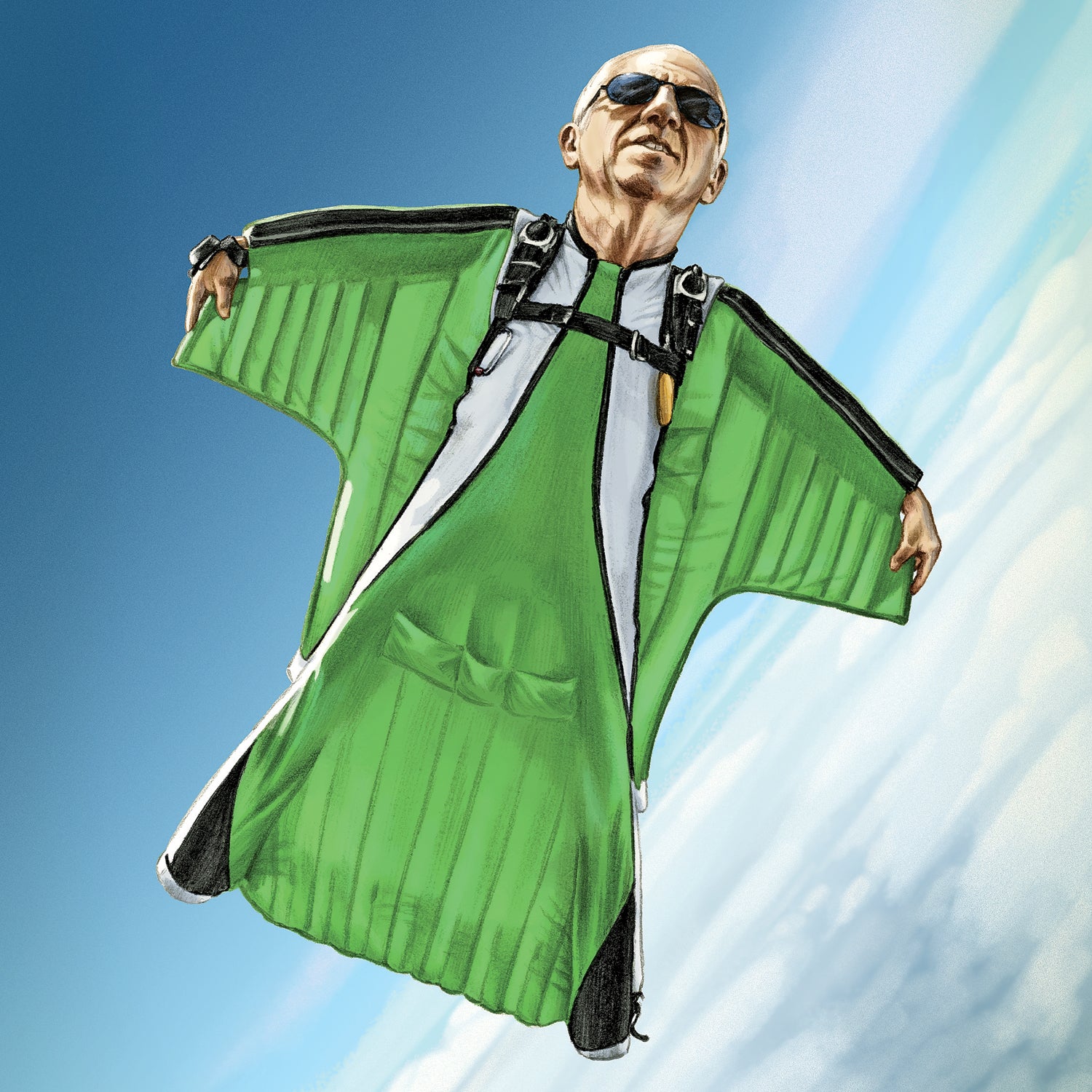“I’m a trial and error dude, not a mathematician,” tells me in a bright Cockney accent. It sounds harmless enough, until you consider that Uragallo, a short 61-year-old with thinning white hair, skin freckled by the sun, and a hitch in his gait from a skydiving accident decades ago, is the world’s preeminent wingsuit maker. His suits have been used to set world records for the longest, farthest, and fastest flights. If you’ve seen the 2011 YouTube video “” (29.4 million views and counting), in which dives from a cliff in Switzerland and flies directly over an accomplice who is holding a bunch of party balloons above his head, you’ve seen an Uragallo creation. Or maybe you’re familiar with Englishman Gary Connery’s jump from a helicopter in 2012, when he made a into a pile of cardboard boxes. Connery was wearing an Uragallo suit, too.
While aviation engineers utilize wind tunnels and computer modeling, Uragallo spends most of his days hunched over a Juki sewing machine in the back room of his workshop in . His guiding lights: decades of sewing experience and what he’s read about Bernoulli’s principle, the scientific law explaining how fluid dynamics create lift. He never attended college and has no formal training in aeronautics, design, or even sewing. It’s mostly intuition. “He visualizes a shape in his mind, and he’s a genius about creating it with a sewing machine and thread,” says Corliss, a 39-year-old Californian and one of the world’s leading wingsuit pilots.
Uragallo is a bit more modest. “I just make prototypes,” he says. “Sometimes, before I’ve even finished one, I’ve got another idea.”
Once he has finished sewing a suit, he uses a leaf blower to inflate it, observes its shape, and examines how well the wings maintain air pressure, which is critical to good glide. Then he drives a few hundred yards down the road to , one of the busiest drop zones in Florida, performs a test flight, and returns to the shop to make more modifications. “It’s almost like a guy who spends his days folding paper airplanes,” says , a 40-year-old climber and wingsuit pilot. “Some might look like a glider, some might look like a rocket or an arrow. He’s always playing around with different folds.”
Long before the wingsuits, Uragallo was a skydiver. He learned in 1970, while serving as a gunner in the British army reserve, and he kept it up after he was discharged in 1972. This was in the early days of the sport, and everyone wore surplus military flight suits when they jumped. Then, one weekend in 1976, Uragallo spotted a skydiver who had a black jumpsuit with a rainbow design. He wanted one of his own, but the money he earned laying bricks and working in the family chip shop wasn’t enough for him to special-order one. So he biked across London, bought a quiver of cotton fabrics, and sewed it himself on his mother’s machine. “I broke a needle every foot,” he recalls.
The results were impressive enough that other skydivers commissioned him to make suits. His family wasn’t supportive of his new hobby, at least at first. “My old man hated the idea of men sewing,” Uragallo says. He persevered, though, buying a top-end sewing machine and cranking out 400 jumpsuits over the next two summers. His creations were popular for their wild designs—lots of stripes and abstract shapes—and loud colors. Increased sales funded travel to compete in international skydiving competitions, where his results—he won the 1978 Australian four-way formation championship—helped grow both his business and his reputation as a skydiver.
Once he has finished sewing a suit, he uses a leaf blower to inflate it, observes its shape, and examines how well the wings maintain air pressure, which is critical to good glide.
In 1979, Uragallo competed in Zephyrhills, a rural, conservative town an hour east of Tampa that had a burgeoning skydiving scene. When he realized that Florida’s warm, sunny weather meant he could skydive year-round, he sold his parachute and harness, got an apartment and car, and set to work.
“Everything was boring until Tony came along,” says , who owns local skydiving shop . Uragallo, who had chaotic red hair and thick glasses, “was always the life of the party,” Murphy says. “The city wasn’t thrilled with the wild and crazy, Hell’s Angels kind of image we had.” In a largely Christian town, the antics of free-spirited skydivers tended to clash with social norms. Uragallo was once evicted for having a child while unmarried.
Late nights and wild parties notwithstanding, by the mid-1990s, had more than 20 employees and distributed its wares in North America, Europe, and Australia. It was around then that a member of the French national skydive team, , took one of Uragallo’s suits and sewed wings under the arms and between the legs, incorporating principles of parachute design to create the modern wingsuit prototype. “He was everybody’s hero,” Uragallo says of Gayardon, who once exited a plane, caught up with it again in flight, and reentered it.
Wingsuits had been around since the earliest days of aviation, but without design standards or adequate training, they were frequently deadly, and most drop zones banned them outright. But Gayardon’s suit was safer and offered superior glide. Over the next decade, a number of other manufacturers began producing them.
Uragallo was wary of the dangers, especially after , but he kept an eye on the market. In 2006, after he sold off the parachute division of Tony Suits, Uragallo felt there was finally enough demand for him to make money on wingsuits. He took to it immediately. The creative problem-solving of making prototypes appealed to his restless mind, and piloting them made skydiving seem boring. “Flying a wingsuit is more like Peter Pan than skydiving ever was,” he says. “Flying around big clouds is the best fun of all.”
British BASE jumper and American Dean Potter had suggested that Uragallo create a suit for BASE jumping that incorporated a parachute container within the suit rather than outside of it, which can disrupt flight. Uragallo created one that featured more surface area than his competitors’. He called it the , and it allowed pilots to fly faster and farther than any suit previously developed, though many sneered at the square silhouette and thick profile. “People made fun of them for looking like flying carpets or dog beds,” says Ogwyn.
But Uragallo, and others flying his suits from cliffs, kept winning competitions. In Switzerland, a jumper approached Boole, who by then was working as a salesman for Tony Suits, and said, “If this suit can make that little fat guy win the fastest competition in the world, it must be really good.”
Uragallo’s new generation of suits transformed the BASE-jumping world. “That was the beginning of proximity flight,” says Ogwyn, referring to the technique in which pilots scream along mountain terrain just feet from the surface. Soon others were making suits with proportions that mimicked Uragallo’s. “They all bloody criticized it for years,” he says. “Now they’re fucking copying it.”
Today, Tony Suits makes approximately 1,500 jumpsuits (which sell for $300 to $500) and 500 wingsuits ($1,000 and up) per year. “I try to tell my employees, ‘You’re not making handbags here,’ ” Uragallo says. “Especially wingsuits. People can die if you mess it up.”
Uragallo has seen that kind of tragedy firsthand. In 1978, he was floating under his parachute when another skydiver in free fall collided with him. Uragallo broke his right leg in five places; the other man was killed. In August 2013, Uragallo was flying in the Swiss Alps with fellow Englishman Mark Sutton . And in May 2014, while flying in Florida. He opened his parachute low and couldn’t correct a malfunction in time to keep him from spinning to the ground. Most recently, in May, Uragallo’s longtime friend Dean Potter died with fellow pilot Graham Hunt in Yosemite National Park.
The added dangers with BASE—the proximity to objects, the lower altitude at the beginning of a flight—can result in tragedies that occasionally overwhelm Uragallo. “I’m sick of people dying,” he says. “You meet them and they’re dead the next week.” Combine that with the physical toll and there are times when Uragallo considers putting away the needle and thread for good. “At my age, it’s more fun to read or work in the garden,” he says.
Ogwyn has considered Uragallo’s absence; he decided it was best to stockpile every suit Uragallo had ever made for him. But retirement is probably years away. Tony’s bright blue eyes still flicker with fresh ideas, the kind that could make his suits even faster and more agile. Sometimes it seems he may never quit. “Trying something new is too exciting,” he says.
The Toll
Wingsuit flying is one of the most dangerous activities on earth. In the past year alone, at least nine pilots have died at jump spots around the world.
Dean Potter, 43
Yosemite National Park, California
Graham Hunt, 29
Yosemite National Park, California
Joshua Sheppard, 31
Jackson, Michigan
Donald Zarda, 44
Anzère, Switzerland
Ramon Rojas, 35
Lauterbrunnen, Switzerland
Beau Weiher, 22
Glacier National Park, Montana
Alex Duncan, 26
Evionnaz, Switzerland
Shaun Otto, 33
Chamonix, France
Abraham Cubo López, 38
Arco, Italy


